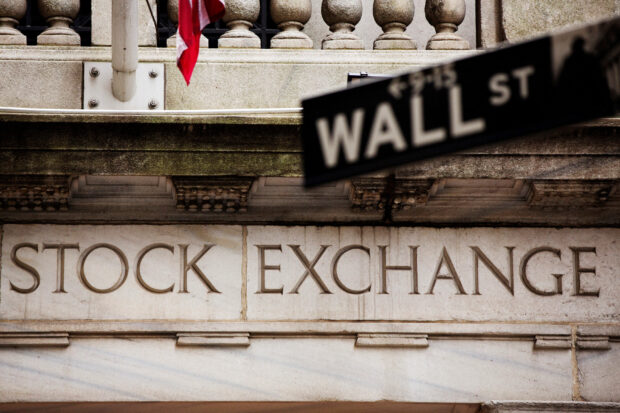
A street sign for Wall Street hangs in front of the New York Stock Exchange. REUTERS/Lucas Jackson/File photo
NEW YORK/LONDON – World stocks soared on Tuesday after U.S. inflation data came in cooler than forecast in October, fueling investor bets that an era of interest rate rises is over and borrowing costs may even soon start to fall.
Data showed U.S. consumer prices were unchanged in October as gasoline prices fell, while underlying inflation showed signs of slowing. Excluding volatile food and energy components, the CPI increased 0.2 percent as rental housing costs rose. Analysts polled by Reuters had expected a 0.3-percent gain.
READ: US consumer prices unchanged; core inflation slowing
By the end of the session in New York, the MSCI World Equity index had surged 1.9 percent.
Stocks also rallied across the board on Wall Street. The S&P 500 index leapt 1.9 percent, the Dow Jones Industrial Average jumped 1.4 percent, and the Nasdaq Composite Index advanced 2.4 percent, its best day since April 27.
“You can say goodbye to the rate hiking era,” said Brian Jacobsen, chief economist at Annex Wealth Management in Wisconsin. He said investors will now turn to bets on when U.S. Federal Reserve policymakers, led by Chair Jerome Powell, might start to cut rates.
“If the Powell Pause began in July, we’ll have to see how long he can hold rates here. In the soft landing of 1994-1995, the pause only last five months.”
Powell and other policymakers said before the latest U.S. inflation data that they were still not sure that interest rates were high enough to tame inflation.
READ: Fed keeps rates unchanged, Powell hedges on possible end of tightening
The pan-European STOXX 600 also jumped after the benign U.S. inflation report, and was last up 1.3 percent.
People walk past the London Stock Exchange Group offices in the City of London, Britain. REUTERS/Toby Melville/File photo
In line with expectations that U.S. rates might have peaked, Treasury yields dropped on Tuesday.
U.S. two-year yields, which reflect interest rate expectations, slid to two-week lows of 4.8318 percent, the biggest one-day drop since May 4. The benchmark 10-year yield fell to 4.4320 percent, a low not seen in nearly eight weeks.
Lower yields dragged the U.S. dollar index down 1.47 percent. A softer dollar boosted the euro 1.7 percent to $1.08765 .
Dollar weakness gave the yen, which has been stuck near its lowest level in three decades against the dollar, a little reprieve.
The pair hovered around 150.325, with the yen recovering slightly from Monday’s 151.92.
“We expect the Bank of Japan to move very, very gradually out of yield curve control and eventually out of negative rate policy, but this is unlikely to happen anytime soon,” Pictet Wealth Management’s macroeconomics chief Frederik Ducrozet said.
READ: BOJ may end negative rates in January, ex-central bank executive says
Euro zone government bond yields were also down. The benchmark 10-year German yield was at 2.596 percent .
The Israel-Hamas war turned traders risk-averse in October, but world stocks have recovered almost 5 percent so far this month as investors bet major central banks have ended a lengthy run of rate hikes.
Asked how long rates would have to stay high to beat inflation, European Central Bank President Christine Lagarde said in an interview over the weekend that no change should be expected in the “next couple of quarters.”
Wages in Britain grew slightly less quickly in the three months to September, official data on Tuesday showed. Wages previously rose at a record pace, leaving the Bank of England on alert for inflation.
The euro zone economy contracted marginally quarter-on-quarter in the third quarter, a new estimate confirmed, underlining expectations of a technical recession if the fourth quarter turns out equally weak, but employment still rose.
Oil prices were unchanged, paring gains eked out after the International Energy Agency (IEA) raised its demand growth forecasts. Brent crude futures stood at $82.47 a barrel, and WTI crude futures finished at $78.26.